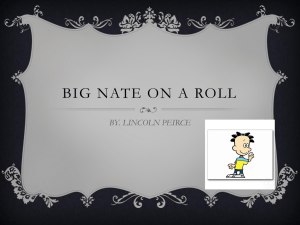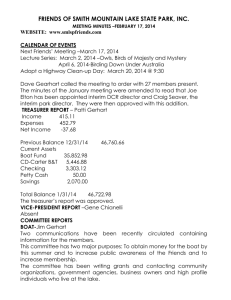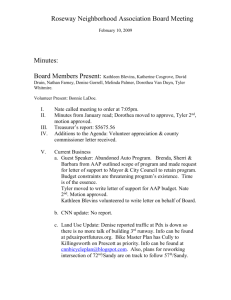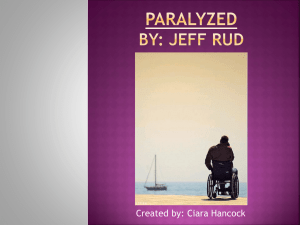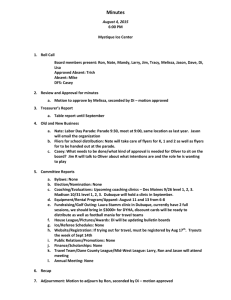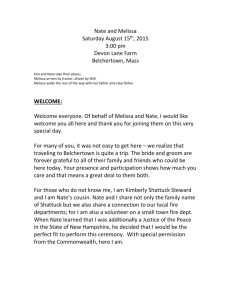National Assistive Technology in Education Network Meeting
advertisement
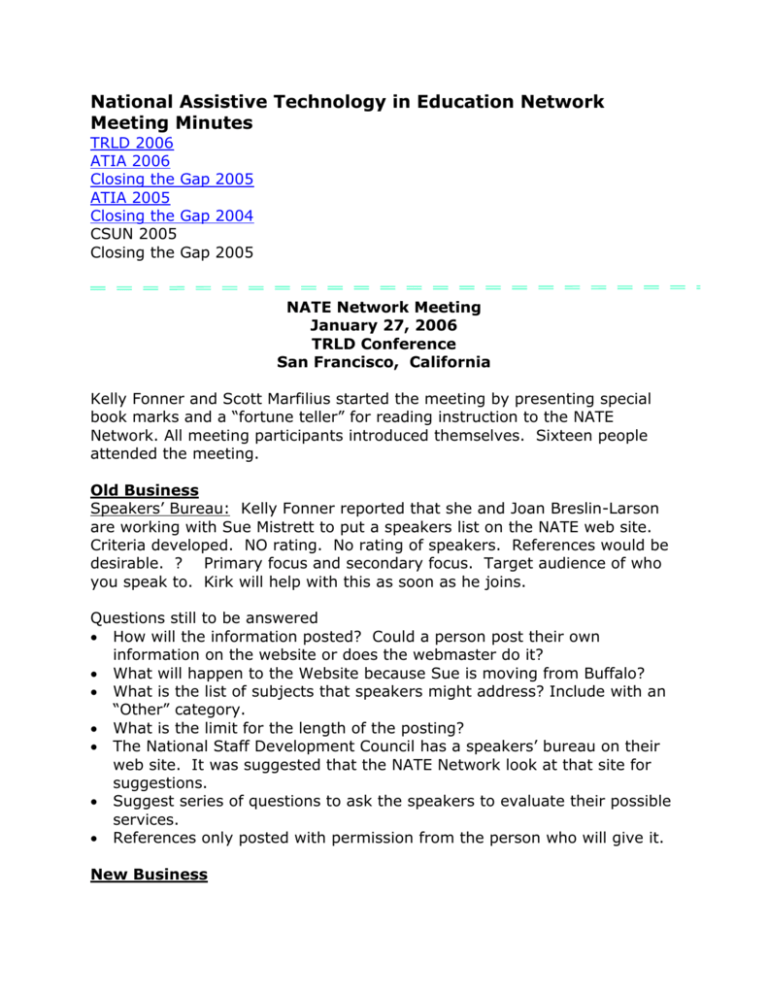
National Assistive Technology in Education Network Meeting Minutes TRLD 2006 ATIA 2006 Closing the Gap 2005 ATIA 2005 Closing the Gap 2004 CSUN 2005 Closing the Gap 2005 NATE Network Meeting January 27, 2006 TRLD Conference San Francisco, California Kelly Fonner and Scott Marfilius started the meeting by presenting special book marks and a “fortune teller” for reading instruction to the NATE Network. All meeting participants introduced themselves. Sixteen people attended the meeting. Old Business Speakers’ Bureau: Kelly Fonner reported that she and Joan Breslin-Larson are working with Sue Mistrett to put a speakers list on the NATE web site. Criteria developed. NO rating. No rating of speakers. References would be desirable. ? Primary focus and secondary focus. Target audience of who you speak to. Kirk will help with this as soon as he joins. Questions still to be answered How will the information posted? Could a person post their own information on the website or does the webmaster do it? What will happen to the Website because Sue is moving from Buffalo? What is the list of subjects that speakers might address? Include with an “Other” category. What is the limit for the length of the posting? The National Staff Development Council has a speakers’ bureau on their web site. It was suggested that the NATE Network look at that site for suggestions. Suggest series of questions to ask the speakers to evaluate their possible services. References only posted with permission from the person who will give it. New Business Regional Supports for Assistive Technology Services A team from the Western SELPA in California attended the meeting. They discussed their regional approach to developing assistive technology services for their constituent districts. They have developed a Learning Community. The Teams has focused on raising the awareness of the need for AT devices and services. All districts have made progress toward. On of the constituent districts invited all department chairs to attend TRLD. Twentyfive percent of professional development had to be used for technology training. They all came together for the conference. The consortium consists of ten districts and each district sends a representative. Have developed a continuum of services but they are focused on teaching their teachers to become fully empowered to do the assessments themselves. Meeting participants suggested that the NATE Network should develop a project that shares information about how to form a regional group. Universal Design for Learning Kirsten Haugen suggested that we need to move toward UDL (Quality Indicators for Universal Design = QIUD). Kirsten is interested in projects that might help to move teachers toward a more universal approach to technology integration. Kirk Behnke mentioned that when the software in the labs in higher education other students with different learning abilities get to use the software and it’s no big deal. Parents as Part of the Team There was a suggestion that additional materials are needed for Families whose children use AT. Parents need additional opportunities to become involved in the discussions and to be collaborative in all areas of AT. Because NATE is a safe and open environment parents could feel free to contribute and participate. Kirsten Haugen likes the idea of monographs for parents and would work on a monograph project. Kelly Fonner suggested that the NATE Network look at the Mothers from Hell Model. One idea was a Parents’ bureau similar to a speakers bureau. Another was the inclusion of family mentors too. A final suggestion was that parents need additional information about AT Implementation strategies for use both at home and at school. The meeting was adjourned at 9:45. NATE Network meeting January 19, 2006 ATIA Conference Orlando, Florida The meeting was called to order at 7:50 by Penny Reed. There were 22 people present. Penny gave a brief history of NATE and its goals. Board members are Gayl Bowser, Denise DeCoste, Marsye Kaplan, Jane Korsten, Sue Mistrett, and Penny Reed. Goal is to support AT Teams and all individuals who provide AT Services no matter what their discipline. NATE’s first publication was the monograph Assistive Technology Assessment: Developing a Written Productivity Profile, by Denise DeCoste. It is now sold by Don Johnston, Inc. and NATE receives a small portion of the profits. The second monograph, Assistive Technology Teams: Many Ways to Do It Well is now being given free to new members. It is also available free on the website as a pdf file. Printed and bound copies can be purchased for $10.00 each for 1-4, $7.50 each for five or more copies, or $5.00 each for 20 or more copies. The focus of NATE is networking across professional boundaries. There is an expectation that the NATE Network members will contribute in some way. The NATE website, www.natenetwork.net has annotated links, a series of forms for collecting data and plans for many more things to come. Penny suggested that new folks go to the NATE website to get application forms in order to join. Following this update, everyone introduced themselves. Treasurer’s report On behalf of Gayl Bowser, Penny reported that there was $2677 in the treasury in October. There are 23 new members since then bringing the total members to over 100. Expenses at Closing the Gap were approximately $500. Old Business NATE Speakers’ bureau update-Joan Breslin-Larson and Kelly Fonner are cochairs of a committee working to develop a Speakers Bureau. Joan reported that they are working on a process and format to provide this information, via a database or a simple list. They have created the criterion (topics, area of expertise, region for travel, expenses,) for the speakers’ bureau and it will be posted on NATE website and/or via email. NATE Mentoring program-Gayl Bowser and Penny Reed have be acting as co-chairs of this committee. They are working on a format. However a small beginning occurred informally at the NATE meeting at CTG in October, where the discussion naturally ended in four mentor/team matches for support. Pre-service education on Assistive Technology-At the October meeting at the Closing the Gap Conference, Froma Cummings suggested that we have preservice expectations for various disciplines. There was discussion at that time and again at this meeting. How do we make that happen on the national level? What is the equivalent pre-service expectation for each discipline? Mathew Press stated that he had volunteered to work on this at the October meeting and has not heard anything. Penny reported that Liz Lahm and Rachel Brady Georgetown are co-chairs of an existing committee. Penny will send them this information. A final thought was that there is a need for resources that are free or inexpensive for both preservice and inservice training. Penny mentioned two new websites with entry level AT information. One is www.teachingat.org. This website would support professors who need to train preservice teachers, even if they didn’t know much about AT. However, it still needs a how-to section for the professor. The other is www.jhu.edu/edtech Debra Newton explained the IRIS group, which developed modules (spec ed) for higher ed coursework aimed at general education teachers. It was suggested that the NATE Network form a subcommittee that would develop/maintain a website with that information. General -At the October meeting participants requested a list of current members. Last week members received an email with a members list. It will be updated and sent out again after the next meeting. New Business A question was asked about how is the information about NATE shared? It has been advertised on QIAT and at CTG. Marsye Kaplan suggested that we need to reach out and say help. Could have a conference session next year about NATE. ATIA is collaborative and embraces organizations. Penny will talk with David Dichter regarding next year. NATE wants to foster the collaboration between disciplines. NATE could consider providing network support (postage,etc) via a mini grant. Deborah Newton asked about having regional meetings. There was discussion during which several others expressed an interest and Penny agreed to bring it before the board to see what they could do to support a regional meeting. It was suggested that Penny put a blurb about NATE in the TAM Connector. She will do that. The next meeting is at TRLD in San Francisco on January 20. Gayl Bowser will be hosting this meeting. Penny asked if there will be anyone at CSUN, but no one present was going to be there. The meeting was adjourned at 8:59 p.m. CTG NATE Meeting October 20, 2005 The meeting was called to order at 7:40 p.m. by Penny Reed. There were approximately 45 people present. Update on publications NATE’s newest monograph, Assistive Technology Teams: Many ways to do it Well was announced. The monograph was available for all members present to pick up at the end of the meeting. The NATE Website was discussed and its URL provided: www.natenetwork.net Treasurer's Report Gayl Bowser reported that we have currently have over 100 members, with several people in the room who want to join. Members pay $35 in dues. Royalties from NATE’s first publication, Assistive Technology Assessment: Developing a Written Productivity Profile, which is now marketed by Don Johnston, Inc. have been almost $1500.00 to date. Current balance in our account is $2677.00 Gayl reminded us that in order to maintain our Nonprofit status we need to give back to the field as much as possible and not acquire too high a balance. The nonprofit status is valuable if we would want to be able to apply for grants if something that fits our goals becomes available. Therefore keeping dues low and only assessing them when needed is a good strategy for us. Old business The following items were discussed: Website additions-Penny reported that the new AT Teams manual will be placed on the website as a pdf file so that it will be available to anyone in that format. Speaker's bureau-Kelly Fonner, Froma Cummings, and Joan BreslinLarson are heading a committee to develop a speaker’s bureau to be listed on the website. Mentoring project-Gayl Bowser and Penny Reed are heading a committee to develop a mentoring project to support individuals new to the field or undertaking new projects. AT in Preservice Programs-Liz Lahm and Rachel Brady are heading the committee to investigate the provision of AT training in preservice programs. o Linda Schleef volunteered o CEC special ed careers has a list of programs that do AT training-Liz will be updating that for a conference in November. o Linda suggested a publication about models for doing AT at the preservice level. It would include resources available. Sue Hardin suggested the ISTE SIG might be a resource. New BusinessUpcoming meetings-TRLD, ATIA, CSUN are possible meetings. Next year’s meeting at CTG was discussed. It was decided to hold it on Wednesday, if possible because there are so many vendor activities on Thursday evening. Cost to purchase monographs was discussed. We cannot sell the Written Productivity Profile due to our agreement with Don Johnston, however, other NATE monographs will be available to purchase for $10 each for 1-4 copies, $7.50 each for 5-19 copies, $5 each for 20 or more copies. Forms-Gayl requested everyone to send her any her forms that they have and she will get them on the website. Liz suggested that if it is online already, it could just be a link. Marsye suggested we have policies on the website or links to them. Linda suggested a Favorite Link Section where a person could suggest an AT link they find useful. Froma wants a group to address the Importance of Motor Specialists in figuring out access. Denise has been working in her district to try to craft statements about what OTs need to know about technology. It was suggested that we mail out a list of members to all members. Sue Hardin asked if we would want to reach out to ISTE and other organizations to let them know about NATE. Sue is part of the Special Education Technology Special Interest group in ISTE. It has about 45 members. They try to have a preconference workshop each year at the NECC conference. They also do an AT playground there. Dr. Betty Nelson has been instrumental in putting that together. They are beginning to see the need to emphasize UDL. David Grapka is also doing an AT playground at the NY ISTE conference. froma is presenting at regional conferences in AZ on AT because AT was the third most important item on their list. Marsye reported that they have presented at their state tech conference. She suggested that is important to use language that appeals to the attendees such as differentiated instruction. Dave and Sue offered to share their information. Mentoring The mentoring program began spontaneously when: Liz Ohta asked for a mentor for Grant writing-Dave Grapka offered to help. Becky Pretli and Kathy Lowry requested mentoring on UDL-Denise DeCoste responded. A school team from Alabama–Marjeena, Kelly and Jeannette requested help in getting their new team started-Jane Korsten volunteered. Matthew Press asked for a mentor-Liz Lahm and Gayl Bowser responded. We will follow up on these at the upcoming meetings to see how this is working. Meeting adjourned at 8:45. ATIA NATE Meeting January 21, 2005 The meeting began with an update of activities including the monographs and website. Monographs-Penny asked for help in reviewing the Team monograph. Sue Mistrett volunteered. There will also be one on Training others. Marsye Kaplan and Penny are working on it. David Grapka who sent his input via email prior to the meeting suggested that we encourage members who are interested in writing additional monographs and support them. That information could be posted on the website. Website-Penny shared a list of initials and acronyms related to special education and assistive technology that will be posted on the website. Three people took copies to give input. That list will be posted in the near future. There was extensive discussion of other information that would be of value on the website. The topics and individuals who volunteered to take the lead on them are as follows: •Speaker’s Bureau on AT Kelly Fonner, Joan Breslin-Larson, and Froma Cummings •Mentoring Project for New AT Providers and Teams Gayl Bowser and Penny Reed •AT Training Including Preservice Programs Liz Lahm and Sue Mistrett •Links To Outcomes Measurement Projects Sue Mistrett •AT Contact People for each State Joan Breslin-Larson and Gayl Bowser Future Meetings The need for meetings was discussed and there was agreement that we should try to hold a NATE meeting at each of the three major AT conferences (ATIA, CSUN, and CTG) and at any additional conference where there may be NATE members. Froma Cummings and Kelly Fonner will take responsibility to host a session at CSUN. (Note as of March 14, they have not been able to secure a site. The are trying for Wednesday, March 16. Please check the message board when you get to the conference.) Any topics may be discussed, but the Speaker’s Bureau will be the major focus of the meeting. It was decided to have the Closing the Gap meeting on Thursday evening even though there are often other vendor events. An agenda and reminder will be mailed prior to the meeting. Additional Topics The need to invite preservice students into NATE and to support their entry into the field was discussed. Rachel Brady and Liz Lahm will take the lead on this. CTG NATE Meeting October 21, 2004 Introductions Penny Reed, President, called the meeting to order. There were 17 people present who introduced themselves. Secretary Treasurer Report Gayl Bowser, Secretary/Treasurer explained that NATE Network is a tax exempt organization and that in order to maintain tax exempt status we must do something for the public good, not just for the good of our members. We currently have 70 members. Accomplishments to Date The website, is up and running. Penny thanked Sue Mistrett for arranging to have it hosted at Buffalo and for her work in creating it. The first monograph, Assistive Technology Assessment: Developing a Written Productivity Profile by Denise DeCoste was completed and provided to members. Penny thanked Denise for making this wonderful resource available. This monograph has been picked up and will be published up by Don Johnston, Inc. A percentage of the profits will come back to NATE Network. Future Plans There are currently two new NATE Network monographs in the works. Denise, Penny, and Marsye Kaplan have been working on a monograph about AT teams. It is anticipated that it will be completed by spring of 2005. Another monograph on preparing and providing workshops has also been started. Marsye and Penny are taking the lead on this. It is anticipated it will be ready in 2006. Penny asked for guidance from those present about the need for a newsletter. In the original planning, a quarterly newsletter was included. Penny was responsible for it and has not accomplished it. There was discussion of existing newsletters. There are two. David Grapka from TreCenter does one and Chauncy Rucker from ConnSense does one. Dave offered to have any NATE Network members added to the list receiving the TRE Center newsletter. It was decided to explore a collaborative effort with existing newsletters rather than sending out one from NATE Network. There was discussion of what would be useful to have on the website. The website is one of the ways we give to the public good, So it is very important. Things that were suggested include: •More forms •Case studies/success stories •Strategies for collecting data about individual and groups of students •Job descriptions •Strategies for building school capacity to provide AT services •List of special ed acronyms •Recommendations of helpful books to read •What you Really Need to Know about AT-from experienced person’s perspective •AT conferences •Full text of future NATE Network monographs Gayl also volunteered to create a CD of forms or other information that would be submitted by members. Additional discussion about how we could support assistive technology service providers led to a decision to explore setting up a one-to-one mentoring system for members. This would allow experienced members to mentor individuals who are new to providing AT in schools. This is important because across the country there are a large number of individuals who will be retiring from AT in the next ten years. Penny and Gayl will put together some potential guidelines for the next meeting. Future meetings: It was decided to hold a meeting at the ATIA Conference in Orlando in January, 2005 and again next year at Closing the Gap, October, 2005. Tentative dates are January 21st (Friday night) and October 21st (Thursday night).
